【大学课件】材料科学基础(中英版)ppt共53页
合集下载
材料科学基础课件PPT
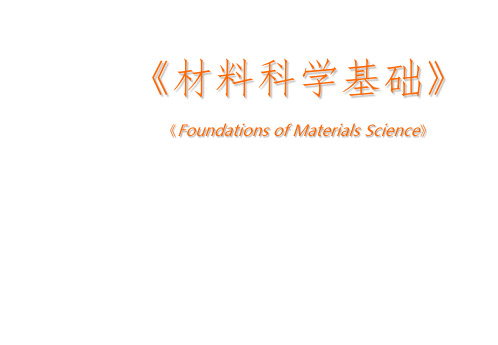
• 材料的结构包括不同晶体结构和非晶体,以及显微镜下的微观 结构,哪些主要因素能够影响和改变结构?只有了解了这些才
能实现控制结构的目的。
• 材料的性能包括物理性能、化学性能、力学性能。
• 其内部结构包括 四个层次:①原 子结构;②结合 键;③原子的排 列方式;④显微 组织
2021/3/10
6
(二)材料科学与材料工程的关系
• 材料科学的形成:“材料”早存在,“材料科学”提出于20世 纪60年代,1957年苏联卫星上天,美国震动很大,在大学相 继建立十余个材料科学研究中心,自此开始,“材料科学”一 词广泛应用。
• 一般来讲,科学是研究“为什么”的学问,而工程是解决“怎 么做”的学问。材料科学的基础理论,为材料工程指明方向,
为更好地选择、使用材料,发挥现有材料的潜力、发展新材料 提供理论基础。
• 材料科学和材料工程之间的区别主要在于着眼点的不同或者说
各自强调的中心不同,它们之间并没有一条明确的界线,因此,
后来人们常常将二者放在一起,采用一个复合名词-材料科学
2021/3/1与0 工程(MSE,Material Science and Engineering)
功能材料:电子材料、光电子材料、超导材料
2021/3/10
10
(四)材料的应用
• 让我们回顾几项有影响的事例,以便加深理解材料的发展在人类社会发 展中起了举足轻重的作用。
• 计算机与材料
1、计算机经历:电子管→晶体管→集成电路时代
2、个人电脑移动存储器的比较
材料科学的发展是计算机飞速发展的基础
种类
《材料科学基础》
《Foundations of Materials Science》
2021/3/10
材料科学基础ppt
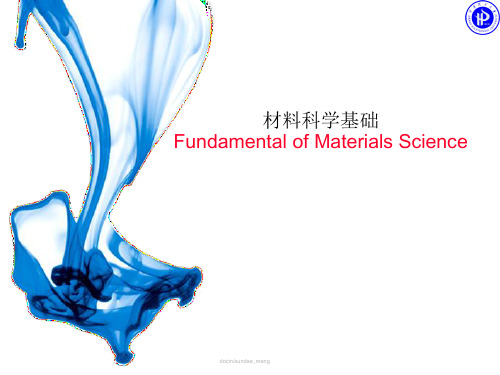
The discipline of materials science involves investigating the relationships that exist among the composition, the structures, the properties and performance of materials. solid matters are the concerns of in materials science. It is based on many fundamental subjects, such as solid physics, thermal dynamics, kinetics, quantum mechanics, metallurgy, and chemistry, etc.
Callister. Essentials of materials Science and Engineering. Donald R. Askeland, Pradeep
P.Phule.
第10页
第一章 绪论 Chapter I An Overview
docin/sundae_meng
Learning Objectives
This course will help you to:
Make and use materials correctly find new applications for materials
第2页
材料科学基础
课程目的:
介绍材料科学与工程的基本概念
学习内容:
材料的组成和结构 材料的组成对性质的影响 加工对材料组成的影响 材料与环境因素的相互作用
What is materials engineering?
Callister. Essentials of materials Science and Engineering. Donald R. Askeland, Pradeep
P.Phule.
第10页
第一章 绪论 Chapter I An Overview
docin/sundae_meng
Learning Objectives
This course will help you to:
Make and use materials correctly find new applications for materials
第2页
材料科学基础
课程目的:
介绍材料科学与工程的基本概念
学习内容:
材料的组成和结构 材料的组成对性质的影响 加工对材料组成的影响 材料与环境因素的相互作用
What is materials engineering?
材料科学基础英文版课件()

Principles of Fracture Mechanics (1)
Brittle fracture of normally ductile materials requires us to have a good understanding of the mechanisms of fracture. To do this, we need to know the knowledge of fracture mechanics Concerned with the relationship between material properties, stress level, crackproducing flaws, and crack propagation mechanisms
Ductile Fracture (1)
Features of ductile fracture
Moderately ductile Some deformation
Macroscopically
Highly ductile Considerable deformation
Necking down to Some necking a point
Kt
m o
2( a )1 2
t
Principles of Fracture Mechanics (3)
It is seen from the above that stress concentration occurs
Not only at microscopic flaws or cracks
Brittle Fracture (2)
Fracture surface markings for brittle fracture
材料科学基础完整ppt课件
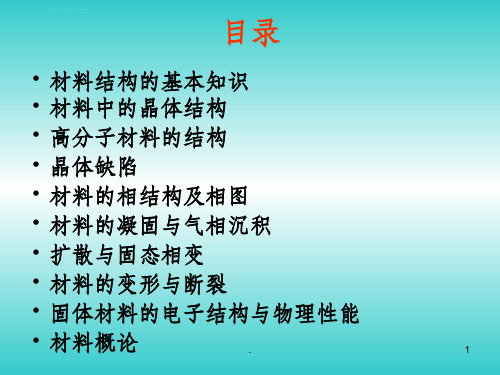
经营者提供商品或者服务有欺诈行为 的,应 当按照 消费者 的要求 增加赔 偿其受 到的损 失,增 加赔偿 的金额 为消费 者购买 商品的 价款或 接受服 务的费 用
离子% 结 )= [-1 e 合 -1 4(X A 键 X B )( 2 1% 00
另一种混合键表现为两种类型的键独立 纯在例如一些气体分子以共价键结合,而 分子凝聚则依靠范德瓦力。聚合物和许多 有机材料的长链分子内部是共价键结合, 链与链之间则是范德瓦力或氢键结合。石 墨碳的上层为共价键结合,而片层间则为 范德瓦力二次键结合。
.
5
经营者提供商品或者服务有欺诈行为 的,应 当按照 消费者 的要求 增加赔 偿其受 到的损 失,增 加赔偿 的金额 为消费 者购买 商品的 价款或 接受服 务的费 用
八.材料科学研究的内容:材料结构的基础知识、
晶体结构、晶体缺陷、材料的相结构及相图、材
料的凝固、材料中的原子扩散、热处理、工程材
料概论等主要内容。 .
子,因此,它们都是良好的电绝缘体。但当
.
16
处在
经营者提供商品或者服务有欺诈行为 的,应 当按照 消费者 的要求 增加赔 偿其受 到的损 失,增 加赔偿 的金额 为消费 者购买 商品的 价款或 接受服 务的费 用
高温熔融状态时,正负离子在外电场作用 下可以自由运动,即呈现离子导电性。
2.共价键
(1)通过共用电子对形成稳定结构
.
13
经营者提供商品或者服务有欺诈行为 的,应 当按照 消费者 的要求 增加赔 偿其受 到的损 失,增 加赔偿 的金额 为消费 者购买 商品的 价款或 接受服 务的费 用
三.结论
1.原子核周围的电子按照四个量子数的规定 从低能到高能依次排列在不同的量子状态 下,同一原子中电子的四个量子数不可能 完全相同。
材料科学基础绪论PPT课件

• 材料的结构包括不同晶体结构和非晶体,以及显微镜下的微 观结构,哪些主要因素能够影响和改变结构?只有了解了这 些才能实现控制结构的目的。
• 材料的性能包括物理性能、化学性能、力学性能。 • 其内部结构包括
四个层次:①原 子结构;②结合 键;③原子的排 列方式;④显微 组织
第4页/共26页
(二)材料科学与材料工程的关系
第2页/共26页
学习料料科学基础的意义 (一)材料科学的内涵
材料科学是一个跨物理、化学等 的学科。材料科学的核心问题是材 料的组织结构(Structure)和性 能(Property)以及它们之间的关 系。右图为材料科学与工程四要素。 所以,先要了解材料的结构是什么?
第3页/共26页
材料结构关系
第24页/共26页
• 1990年美国总统的科学顾问Allany Bromley明确指出“材料科学在美 国是最重要的学科”。
• 1991年日本为未来工业规划技术列举的11项主要项目中有7项是基于先 进材料之上。
• 1986年《科学的美国人》杂志指出“先进材料对未来的宇航、电子设备、 汽车以及其他工业的发展是必要的,材料科学的进步决定了经济关键部 门增长速率的极限范围。”
• 材料科学的形成:“材料”早存在,“材料科学”提出于 20世纪60年代,1957年苏联卫星上天,美国震动很大, 在大学相继建立十余个材料科学研究中心,自此开始, “材料科学”一词广泛应用。
• 一般来讲,科学是研究“为什么”的学问,而工程是解决 “怎么做”的学问。材料科学的基础理论,为材料工程指 明方向,为更好地选择、使用材料,发挥现有材料的潜力、 发展新材料提供理论基础。
《济地的制造有用物品的物质。 材料科学是研究材料的成分、组织结构、制备工艺、加工工艺、材料 的性能与材料应用之间的相互关系的科学。材料科学是当代科学技术发展 的基础、工业生产的支柱,是当今世界的带头学科之一。纳米材料科学与 技术是20世纪80年代发展起来的新兴学科,成为21世纪新技术的主导中 心。 材料科学基础是进行材料科学研究的基础理论,它将各种材料(包括 金属、陶瓷、高分子材料)的微观结构和宏观结构规律建立在共同的理论 基础上,用于指导材料的研究、生产、应用和发展。它涵盖了材料科学和 材料工程的基础理论。
• 材料的性能包括物理性能、化学性能、力学性能。 • 其内部结构包括
四个层次:①原 子结构;②结合 键;③原子的排 列方式;④显微 组织
第4页/共26页
(二)材料科学与材料工程的关系
第2页/共26页
学习料料科学基础的意义 (一)材料科学的内涵
材料科学是一个跨物理、化学等 的学科。材料科学的核心问题是材 料的组织结构(Structure)和性 能(Property)以及它们之间的关 系。右图为材料科学与工程四要素。 所以,先要了解材料的结构是什么?
第3页/共26页
材料结构关系
第24页/共26页
• 1990年美国总统的科学顾问Allany Bromley明确指出“材料科学在美 国是最重要的学科”。
• 1991年日本为未来工业规划技术列举的11项主要项目中有7项是基于先 进材料之上。
• 1986年《科学的美国人》杂志指出“先进材料对未来的宇航、电子设备、 汽车以及其他工业的发展是必要的,材料科学的进步决定了经济关键部 门增长速率的极限范围。”
• 材料科学的形成:“材料”早存在,“材料科学”提出于 20世纪60年代,1957年苏联卫星上天,美国震动很大, 在大学相继建立十余个材料科学研究中心,自此开始, “材料科学”一词广泛应用。
• 一般来讲,科学是研究“为什么”的学问,而工程是解决 “怎么做”的学问。材料科学的基础理论,为材料工程指 明方向,为更好地选择、使用材料,发挥现有材料的潜力、 发展新材料提供理论基础。
《济地的制造有用物品的物质。 材料科学是研究材料的成分、组织结构、制备工艺、加工工艺、材料 的性能与材料应用之间的相互关系的科学。材料科学是当代科学技术发展 的基础、工业生产的支柱,是当今世界的带头学科之一。纳米材料科学与 技术是20世纪80年代发展起来的新兴学科,成为21世纪新技术的主导中 心。 材料科学基础是进行材料科学研究的基础理论,它将各种材料(包括 金属、陶瓷、高分子材料)的微观结构和宏观结构规律建立在共同的理论 基础上,用于指导材料的研究、生产、应用和发展。它涵盖了材料科学和 材料工程的基础理论。
材料科学基础双语课件
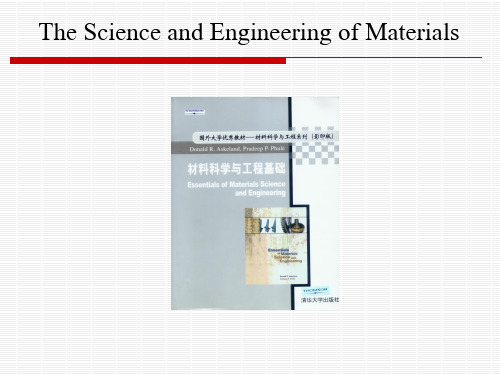
control the material properties (for example by altering the
grain structure, or the presence of defects in the atom
packing) or to fabricate the material into the desired shape.
extra material, joining parts (e.g., by soldering or welding),
forming (forging, rolling, bending, etc.), or compacting particles which are then fused together (sintering, used for
gases (and most engineering materials are used in solid
form).
1.1 What is Materials Science and Engineering?
It may seem abstract and remote from real engineering to
The Science and Engineering of Materials
Aim
English atmosphere: speaking, reading, writing and lisห้องสมุดไป่ตู้ening; Specialty vocabulary; Specialty knowledge;
form. As this mixture solidifies, different structures form as a function of temperature. The phase diagrams that provide
grain structure, or the presence of defects in the atom
packing) or to fabricate the material into the desired shape.
extra material, joining parts (e.g., by soldering or welding),
forming (forging, rolling, bending, etc.), or compacting particles which are then fused together (sintering, used for
gases (and most engineering materials are used in solid
form).
1.1 What is Materials Science and Engineering?
It may seem abstract and remote from real engineering to
The Science and Engineering of Materials
Aim
English atmosphere: speaking, reading, writing and lisห้องสมุดไป่ตู้ening; Specialty vocabulary; Specialty knowledge;
form. As this mixture solidifies, different structures form as a function of temperature. The phase diagrams that provide
材料科学基础ppt课件
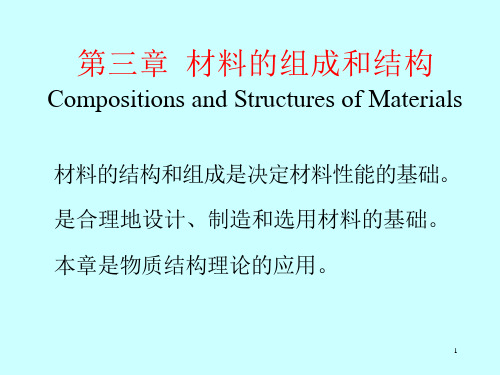
11
• 这类聚合物是由缩聚反应或开环聚合而成的, 因主链带极性,易水解,醇解或酸解
• 优点:耐热性好,强度高 • 缺点:易水解
• 这类聚合物主要用作工程塑料
12
元素高分子
➢主链中不含碳原子,而是由Si 、B 、As等元素和O元 素组成,但在侧链上含有有机取代基团。这类高分 子兼具无机和有机高分子特性,如有机硅高分子。
• 支化高分子的形式:星形(Star)、 梳形 (Comb)、无规(Random)
23
网状(交联)大分子
• 缩聚反应中有三个或三个以上官能 度的单体存在时,高分子链之间通 过支链联结成一个三维空间网形大 分子时即成交联结构
• 交联与支化有本质区别 支化(可溶,可熔,有软化点) 交联(不溶,不熔,可膨胀)
2
•
3-1 材料组成和结构的基本内容
Principal Contents of Materials Composition and Structures
• 材料的组成: 构成材料的基本单元的成分及数目
• 材料的结构: 材料的组成单元(即原子或分子)之间相互吸引 和相互排斥作用达到平衡时在空间的几何排列。
(2)
结构单元 的键接方式 ( 几何构型 Geometric
Configuration) (链节)
16
加聚
缩聚
• 由以上知:
• 由于高分子是链状结构,所以把简单重复(结构)单元称为“链节”(chains) • 简单重复(结构)单元的个数称为聚合度DP(Degree of Polymerization1
28
无 规 共 聚 ( random)
• 两种高分子无规则地平行联结
ABAABABBAAABABBAAA
• 这类聚合物是由缩聚反应或开环聚合而成的, 因主链带极性,易水解,醇解或酸解
• 优点:耐热性好,强度高 • 缺点:易水解
• 这类聚合物主要用作工程塑料
12
元素高分子
➢主链中不含碳原子,而是由Si 、B 、As等元素和O元 素组成,但在侧链上含有有机取代基团。这类高分 子兼具无机和有机高分子特性,如有机硅高分子。
• 支化高分子的形式:星形(Star)、 梳形 (Comb)、无规(Random)
23
网状(交联)大分子
• 缩聚反应中有三个或三个以上官能 度的单体存在时,高分子链之间通 过支链联结成一个三维空间网形大 分子时即成交联结构
• 交联与支化有本质区别 支化(可溶,可熔,有软化点) 交联(不溶,不熔,可膨胀)
2
•
3-1 材料组成和结构的基本内容
Principal Contents of Materials Composition and Structures
• 材料的组成: 构成材料的基本单元的成分及数目
• 材料的结构: 材料的组成单元(即原子或分子)之间相互吸引 和相互排斥作用达到平衡时在空间的几何排列。
(2)
结构单元 的键接方式 ( 几何构型 Geometric
Configuration) (链节)
16
加聚
缩聚
• 由以上知:
• 由于高分子是链状结构,所以把简单重复(结构)单元称为“链节”(chains) • 简单重复(结构)单元的个数称为聚合度DP(Degree of Polymerization1
28
无 规 共 聚 ( random)
• 两种高分子无规则地平行联结
ABAABABBAAABABBAAA
材料科学基础简介PPT课件

37
第37页/共47页
发展期
当高分子理论促进了合成高分子工 业的发展后,出现了一大批商品化 的合成材料,这些合成高分子(合 成材料)的出现,又为理论研究提 供了大量的实验依据和积累了丰富 的数据,促进了高分子物理学的迅 速发展。
38
第38页/共47页
30~40年代,高物领域最有代表性的工作: W.Kuhn、E.Guth和H.Mark等把统计力学用于高 分子链的构象统计,建立了橡胶高弹性统计理论 Svedbergy用超离心技术测定蛋白质的分子量 1942年,Flory和Huggins用似晶格模型推导出高分 子溶液的热力学性质,理论上的解释了高分子稀溶 液的依数性质 Debeye和Zimm用光散射法研究高分子溶液性质, 测定了Mw
7
第7页/共47页
8
第8页/共47页
9
第9页/共47页
第二节 材料的类别
1. 金属材料(metals)
1.1分类 (1)黑色金属材料-主要是指钢铁材料。 钢(Steel) 按化学成分分碳素钢、合金钢等;按品
质分普通、优质、高级优质钢等;按金相组织或组织结 构分珠光体、贝氏体、马氏体和奥氏体钢等;按用途分 建筑工程、结构、工具、特殊性能、专业用钢等;按冶 炼方法分平炉、转炉、电炉、沸腾炉钢等。
16
第16页/共47页
17
第17页/共47页
18
第18页/共47页
2.2 结构
1、离子键:大多数盐类、碱类和金属氧化物主要 以离子键的方式结合。离子键键合的基本特点是以 离子而不是以原子为结合单元。
19
第19页/共47页
一般离子晶体中正负离子静电引力较强, 结合牢固。因此。其熔点和硬度均较高。另 外,在离子晶体中很难产生自由运动的电子, 因此,它们都是良好的电绝缘体。但当处在 高温熔融状态时,正负离子在外电场作用下 可以自由运动,即呈现离子导电性。 2.共价键
第37页/共47页
发展期
当高分子理论促进了合成高分子工 业的发展后,出现了一大批商品化 的合成材料,这些合成高分子(合 成材料)的出现,又为理论研究提 供了大量的实验依据和积累了丰富 的数据,促进了高分子物理学的迅 速发展。
38
第38页/共47页
30~40年代,高物领域最有代表性的工作: W.Kuhn、E.Guth和H.Mark等把统计力学用于高 分子链的构象统计,建立了橡胶高弹性统计理论 Svedbergy用超离心技术测定蛋白质的分子量 1942年,Flory和Huggins用似晶格模型推导出高分 子溶液的热力学性质,理论上的解释了高分子稀溶 液的依数性质 Debeye和Zimm用光散射法研究高分子溶液性质, 测定了Mw
7
第7页/共47页
8
第8页/共47页
9
第9页/共47页
第二节 材料的类别
1. 金属材料(metals)
1.1分类 (1)黑色金属材料-主要是指钢铁材料。 钢(Steel) 按化学成分分碳素钢、合金钢等;按品
质分普通、优质、高级优质钢等;按金相组织或组织结 构分珠光体、贝氏体、马氏体和奥氏体钢等;按用途分 建筑工程、结构、工具、特殊性能、专业用钢等;按冶 炼方法分平炉、转炉、电炉、沸腾炉钢等。
16
第16页/共47页
17
第17页/共47页
18
第18页/共47页
2.2 结构
1、离子键:大多数盐类、碱类和金属氧化物主要 以离子键的方式结合。离子键键合的基本特点是以 离子而不是以原子为结合单元。
19
第19页/共47页
一般离子晶体中正负离子静电引力较强, 结合牢固。因此。其熔点和硬度均较高。另 外,在离子晶体中很难产生自由运动的电子, 因此,它们都是良好的电绝缘体。但当处在 高温熔融状态时,正负离子在外电场作用下 可以自由运动,即呈现离子导电性。 2.共价键
【大学】材料科学基础(中英版)
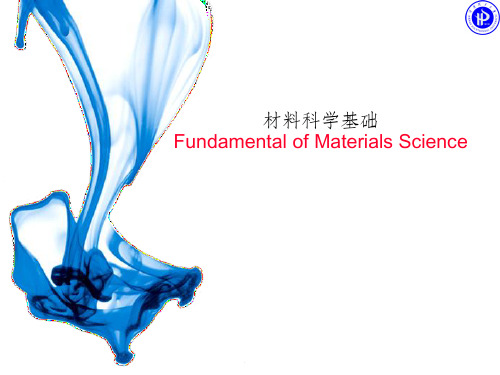
Materials in first industrial revolution (1881-1935). Materials in second industrial revolution (1935-1980). Materials today – too,ooo,ooo… many (1980- ).
第21页
Materials science and engineering
The relationship between materials science and materials engineering
Materials science Why it has…
Materials engineering How to make…
Time: Location: Activities:
Present new study material Announce reading and homework Take quizzes
第4页
授课信息
授课人: 时间: 地点: 主要活动:
教授新课 布置作业 课堂测验
第5页
Recitations
第1Байду номын сангаас页
What is material?
Classifications of materials
Based on the chemical composition: Metals, Non-metal inorganic materials (ceramic mateials) Polymers, Composites
Materials, energy and information are the three pillars of current human civilization.
第21页
Materials science and engineering
The relationship between materials science and materials engineering
Materials science Why it has…
Materials engineering How to make…
Time: Location: Activities:
Present new study material Announce reading and homework Take quizzes
第4页
授课信息
授课人: 时间: 地点: 主要活动:
教授新课 布置作业 课堂测验
第5页
Recitations
第1Байду номын сангаас页
What is material?
Classifications of materials
Based on the chemical composition: Metals, Non-metal inorganic materials (ceramic mateials) Polymers, Composites
Materials, energy and information are the three pillars of current human civilization.
材料科学基础英文版课件-(13)
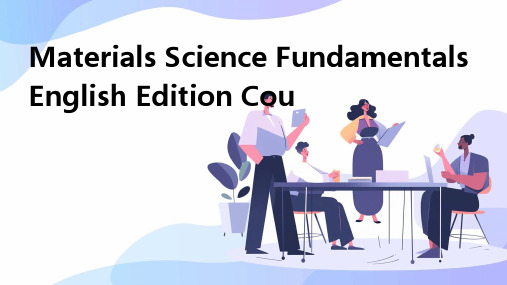
Ductility
The ability of a material to be stretched without breaking.
Toughness
The ability of a material to absorb energy before fracturing.
Physical Properties
Some common examples of polymers include plastic, rubber, and fiberglass.
Polymers can be natural or synthetic.
Composites
Composites are materials that consist of two or more materials with different physical and chemical properties.
Nondestructive testing techniques: 超声波检测,射线检测,涡流检测等 。
02
Materials Properties
Mechanical Properties
Elasticity
The ability of a material to return to its original shape after being deformed by an external force.
Metals
Metals are materials that are typically ductile, malleable, and conduct electricity well.
They are often used in the manufacturing of various
清华材料科学基础课件(英文)skja_14

L l 1 2 cos cos cos
2 2
L b sin 0
n cos 0
l
sin
cos
② In compression
2012-8-30
A a (a b )n
材料科学基础
2. Change in orientation ① Orientation change and multislip
1. for Ⅰ: Easy-glide 2. for Ⅱ: Linear hardening
d dr
Ⅲ I Ⅱ
is very great
dr
3. for Ⅲ: Parabolic hardening d ↓ flow stress
2012-8-30 材料科学基础
How to obtain curve
[0 1 1] b 2
[ 1 11] 3 [ 2 1 5] 6[0 1 1] v 1 6 2 ) [0 1 1] 2
R ∥[211]
[uvw] [ 2 1 5] ([ 2 1 5]
u 2 0 2 w6
6 6
F // [ 2 26] // [ 1 1 3]
2012-8-30
材料科学基础
1 011
<111>
c
BCC
{112}
BCC: {112
<112>
a1
{10 1 2}
FCC: {111}<112>
2012-8-30 材料科学基础
HCP:{10 1 2} 1 011
Ⅲ.Atom movements in twinning of FCC
2材料科学基础英文版课件_
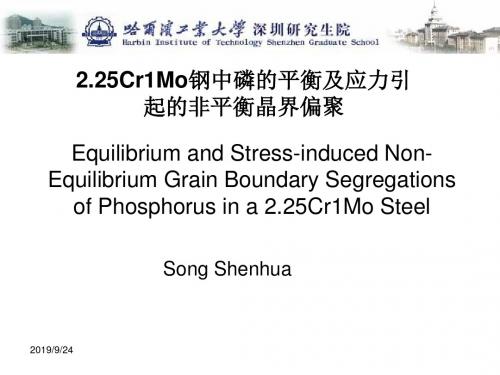
• Stress-induced non-equilibrium grain boundary
segregation – Introduction, experiment, results and discussion,
summary
• Conclusions
2019/9/24
Outline (1)
Ingot
Block 1
Sample processing and pretreatment
Pretreated samples
Aging at different temperatures for different times and quenching
Machining
2019/9/24
Experiment (2)
Applied stress
2019/9/24
2.25Cr1Mo steel
Outline (1)
• Equilibrium grain boundary segregation
– Segregation of phosphorus and molybdenum
• Introduction, experiment, results and discussion, summary
520℃
2019/9/24
Time
Heat treatment procedure
Experiment (4)
Auger electron spectrometer
2019/9/24
Auger specimen
Experiment (5)
2019/9/24
AES scanning position
– Effect of phosphorus grain boundary segregation on intergranular fracture
segregation – Introduction, experiment, results and discussion,
summary
• Conclusions
2019/9/24
Outline (1)
Ingot
Block 1
Sample processing and pretreatment
Pretreated samples
Aging at different temperatures for different times and quenching
Machining
2019/9/24
Experiment (2)
Applied stress
2019/9/24
2.25Cr1Mo steel
Outline (1)
• Equilibrium grain boundary segregation
– Segregation of phosphorus and molybdenum
• Introduction, experiment, results and discussion, summary
520℃
2019/9/24
Time
Heat treatment procedure
Experiment (4)
Auger electron spectrometer
2019/9/24
Auger specimen
Experiment (5)
2019/9/24
AES scanning position
– Effect of phosphorus grain boundary segregation on intergranular fracture
材料科学基础PPT课件
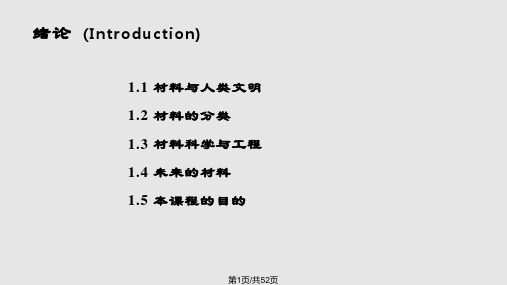
第35页/共52页
Y-Sialon
材料观-结构
宏观结构 微观结构
第36页/共52页
结构的含义
宏观结构(眼睛观察范围-0.1mm) 显微结构(晶粒尺寸、分布、100m-0.1
m) 晶体结构(晶胞、晶格、Angstron) 原子结构(电子+质子+中子)
第37页/共52页
结构分析的工具
第38页/共52页
性能
材料性能:材料对外界作用的响应 力学性质:形变与断裂 热学性质:热容量、热导率、热膨胀 电学性质:电导率,介电性质 磁学性质:磁化率等 光学性质:折射或反射 劣化:材料的化学活性
第39页/共52页
组成-工艺过程-结构-性质之间关系 材料科学核心内 容
组成+加工工艺
微观组织结构
性能
大部分耐火材料是以天然矿石(如耐火粘土、硅石、 菱镁矿、白云母等)为原料制造的
第17页/共52页
3. 有机高分子材料(高聚物)
高聚物是由一种或几种简单 低分子化合物经聚合而组成 的分子量很大的化合物
高聚物的种类繁多,性能各 异,其分类的方法多种多样
按高分子材料来源分为天然
高分子材料和合成高分子材
℃,具有良好的塑性,能承受冷热加工 第27页/共52页
工艺过程-结构(显微结构)
aluminium before refinement
aluminium after refinement
第28页/共52页
不同加工方法的工件组织与性能
第29页/共52页
结构的含义
宏观结构(眼睛观察范围0.1mm)
第10页/共52页
金属材料
在103种元素中,除6种惰性元素和16种非金属元素 外,81种为金属元素。
- 1、下载文档前请自行甄别文档内容的完整性,平台不提供额外的编辑、内容补充、找答案等附加服务。
- 2、"仅部分预览"的文档,不可在线预览部分如存在完整性等问题,可反馈申请退款(可完整预览的文档不适用该条件!)。
- 3、如文档侵犯您的权益,请联系客服反馈,我们会尽快为您处理(人工客服工作时间:9:00-18:30)。
What is materials science?
The discipline of materials science involves investigating the relationships that exist among the composition, the structures, the properties and performance of materials. solid matters are the concerns of in materials science. It is based on many fundamental subjects, such as solid physics, thermal dynamics, kinetics, quantum mechanics, metallurgy, and chemistry, etc.
第20页
材料科学与工程
什么是材料科学?
材料科学是一门以固体材料为研究对象,以固体物理、热力学、动力学、 量子力学、冶金、化学为基础的应用学科,主要探讨材料的组成、结构与 性能之间的规律的一门基础应用学科,是研究材料共性的一门学科。
什么是材料工程
材料工程是对材料的结构进行设计和处理,并制备出具有某些特定性质的 工艺即工程技术问题。
材料科学基础 Fundamental of Materials Science
docin/sundae_meng
Fundamental of Materials Science
Course objective…
Introduce fundamental concepts in MSE
You will learn about:
第12页
学习目标
列出四种固体材料及其物理化学特性 列出四种传统的无机非金属材料 列出不同类型的先进无机非金属材料 了解无机非金属材料的特性 了解无机非金属材料的合成方法 了解无机非金属产品的制备工艺 掌握无机非金属材料的选用原则
第13页
Contents
What is material
Materials and civilization Classification of materials
第16页
What is material?
Materials and civilization
Different materials are milestones of human early civilizations. Old stone age (250,000BC~10,000BC). New stone age (10,000BC-3,000BC). Bronze age (3,000~1BC). Iron age (1AD~1880AD).
Materials in first industrial revolution (1881-1935). Materials in second industrial revolution (1935-1980). Materials today – too,ooo,ooo… many (1980- ).
What is materials engineering?
In contrast, materials engineering is techniques of designing or engineering the structure of a material to produce a predetermined set of properties.
Recitations
Instructor: Times Location: Purpose:
review lecture concepts discuss homework, quizzes exams
第6页
习题课
指导人: 时间: 地点 目的:
复习课程内容 讨论作业、小测验和期中考试
Inorganic materials
Traditional inorganic materials Advanced inorganic materials
Characteristic of inorganic materials Synthesis and processing of inorganic materials Selection of inorganic materials Contents of materials science and engineering
第9页
Course book
Textbook
《无机材料科学基础》,宋晓岚,黄学辉,化学工业出版社,2019 Fundamentals of Ceramics, Michel Barsoum, Institute of Physics, 2019
References
《材料导论》,师昌绪,化学工业出版社,2019 《材料科学基础》,陆佩文,武汉理工大学出版社, 2019 《材料科学基础》,潘金生,清华大学出版社,2019 《材料科学与工程基础》,(美)史密斯等,机械工业出版社,2019 Fundamentals of materials science and engineering. (fifth edition) William D.
第7页
Teaching Schedule
Session 1: General intro Session 2: Atomic bonding Session 3: Symmetry
第8页
Grading
期末闭卷考试(Final exam):60% 实验(Lab):10% 平时考勤(Attendance): 10% 课程报告 (Project): 10% 课后作业 (Homework): 10%
Time: Location: Activities:
Present new study material Announce reading and homework Take quizzes
第4页
授课信息
授课人: 时间: 地点: 主要活动:
教授新课 布置作业 课堂测验
第5页
Callister. Essentials of materials Science and Engineering. Donald R. Askeland, Pradeep
P.Phule.
第10页
第一章 绪论 Chapter I An Overview
docin/sundae_meng
Learning Objectives
第17页
What is material?
Classifications of materials
Based on the chemical composition: Metals, Non-metal inorganic materials (ceramic mateials) Polymers, Composites
课程目标:
正确制备与使用材料 实现材料的创新应用设计
第3页
lectures
Lecturer: Total course times
64 hours Lectures: 28 sessions, 2 hours / week Recitations: 2 sessions, 2 hours / session 2 experiments, 2 sessions.
Based on physical properties Based on the industrial applications
第18页
1.1 什么是材料
材料的分类
金属材料 无机非金属材料 高分子材料 复合材料
第19页
Materials science and engineering
What is material?
Materials is physical substance which may be shaped or manipulated to make tools, instruments, or products. Materials are matters, however, not all matters are materials.
This course will help you to:
Make and use materials correctly find new applications for materials
第2页
材料科学基础
课程目的:
介绍材料科学与工程的基本概念
学习内容:
材料的组成和结构 材料的组成对性质的影响 加工对材料组成的影响 材料与环境因素的相互作用
List the four primary classifications of solid materials and then cite the distinctive physical & chemical feature of each. List four different traditional inorganic materials. List different types of advanced inorganic materials. Cite the general characteristics of inorganic materials. Cite the synthesis of inorganic materials. Cite the general manufacture process of inorganic products. Understand the principles of selection of inorganic materials.
The discipline of materials science involves investigating the relationships that exist among the composition, the structures, the properties and performance of materials. solid matters are the concerns of in materials science. It is based on many fundamental subjects, such as solid physics, thermal dynamics, kinetics, quantum mechanics, metallurgy, and chemistry, etc.
第20页
材料科学与工程
什么是材料科学?
材料科学是一门以固体材料为研究对象,以固体物理、热力学、动力学、 量子力学、冶金、化学为基础的应用学科,主要探讨材料的组成、结构与 性能之间的规律的一门基础应用学科,是研究材料共性的一门学科。
什么是材料工程
材料工程是对材料的结构进行设计和处理,并制备出具有某些特定性质的 工艺即工程技术问题。
材料科学基础 Fundamental of Materials Science
docin/sundae_meng
Fundamental of Materials Science
Course objective…
Introduce fundamental concepts in MSE
You will learn about:
第12页
学习目标
列出四种固体材料及其物理化学特性 列出四种传统的无机非金属材料 列出不同类型的先进无机非金属材料 了解无机非金属材料的特性 了解无机非金属材料的合成方法 了解无机非金属产品的制备工艺 掌握无机非金属材料的选用原则
第13页
Contents
What is material
Materials and civilization Classification of materials
第16页
What is material?
Materials and civilization
Different materials are milestones of human early civilizations. Old stone age (250,000BC~10,000BC). New stone age (10,000BC-3,000BC). Bronze age (3,000~1BC). Iron age (1AD~1880AD).
Materials in first industrial revolution (1881-1935). Materials in second industrial revolution (1935-1980). Materials today – too,ooo,ooo… many (1980- ).
What is materials engineering?
In contrast, materials engineering is techniques of designing or engineering the structure of a material to produce a predetermined set of properties.
Recitations
Instructor: Times Location: Purpose:
review lecture concepts discuss homework, quizzes exams
第6页
习题课
指导人: 时间: 地点 目的:
复习课程内容 讨论作业、小测验和期中考试
Inorganic materials
Traditional inorganic materials Advanced inorganic materials
Characteristic of inorganic materials Synthesis and processing of inorganic materials Selection of inorganic materials Contents of materials science and engineering
第9页
Course book
Textbook
《无机材料科学基础》,宋晓岚,黄学辉,化学工业出版社,2019 Fundamentals of Ceramics, Michel Barsoum, Institute of Physics, 2019
References
《材料导论》,师昌绪,化学工业出版社,2019 《材料科学基础》,陆佩文,武汉理工大学出版社, 2019 《材料科学基础》,潘金生,清华大学出版社,2019 《材料科学与工程基础》,(美)史密斯等,机械工业出版社,2019 Fundamentals of materials science and engineering. (fifth edition) William D.
第7页
Teaching Schedule
Session 1: General intro Session 2: Atomic bonding Session 3: Symmetry
第8页
Grading
期末闭卷考试(Final exam):60% 实验(Lab):10% 平时考勤(Attendance): 10% 课程报告 (Project): 10% 课后作业 (Homework): 10%
Time: Location: Activities:
Present new study material Announce reading and homework Take quizzes
第4页
授课信息
授课人: 时间: 地点: 主要活动:
教授新课 布置作业 课堂测验
第5页
Callister. Essentials of materials Science and Engineering. Donald R. Askeland, Pradeep
P.Phule.
第10页
第一章 绪论 Chapter I An Overview
docin/sundae_meng
Learning Objectives
第17页
What is material?
Classifications of materials
Based on the chemical composition: Metals, Non-metal inorganic materials (ceramic mateials) Polymers, Composites
课程目标:
正确制备与使用材料 实现材料的创新应用设计
第3页
lectures
Lecturer: Total course times
64 hours Lectures: 28 sessions, 2 hours / week Recitations: 2 sessions, 2 hours / session 2 experiments, 2 sessions.
Based on physical properties Based on the industrial applications
第18页
1.1 什么是材料
材料的分类
金属材料 无机非金属材料 高分子材料 复合材料
第19页
Materials science and engineering
What is material?
Materials is physical substance which may be shaped or manipulated to make tools, instruments, or products. Materials are matters, however, not all matters are materials.
This course will help you to:
Make and use materials correctly find new applications for materials
第2页
材料科学基础
课程目的:
介绍材料科学与工程的基本概念
学习内容:
材料的组成和结构 材料的组成对性质的影响 加工对材料组成的影响 材料与环境因素的相互作用
List the four primary classifications of solid materials and then cite the distinctive physical & chemical feature of each. List four different traditional inorganic materials. List different types of advanced inorganic materials. Cite the general characteristics of inorganic materials. Cite the synthesis of inorganic materials. Cite the general manufacture process of inorganic products. Understand the principles of selection of inorganic materials.
